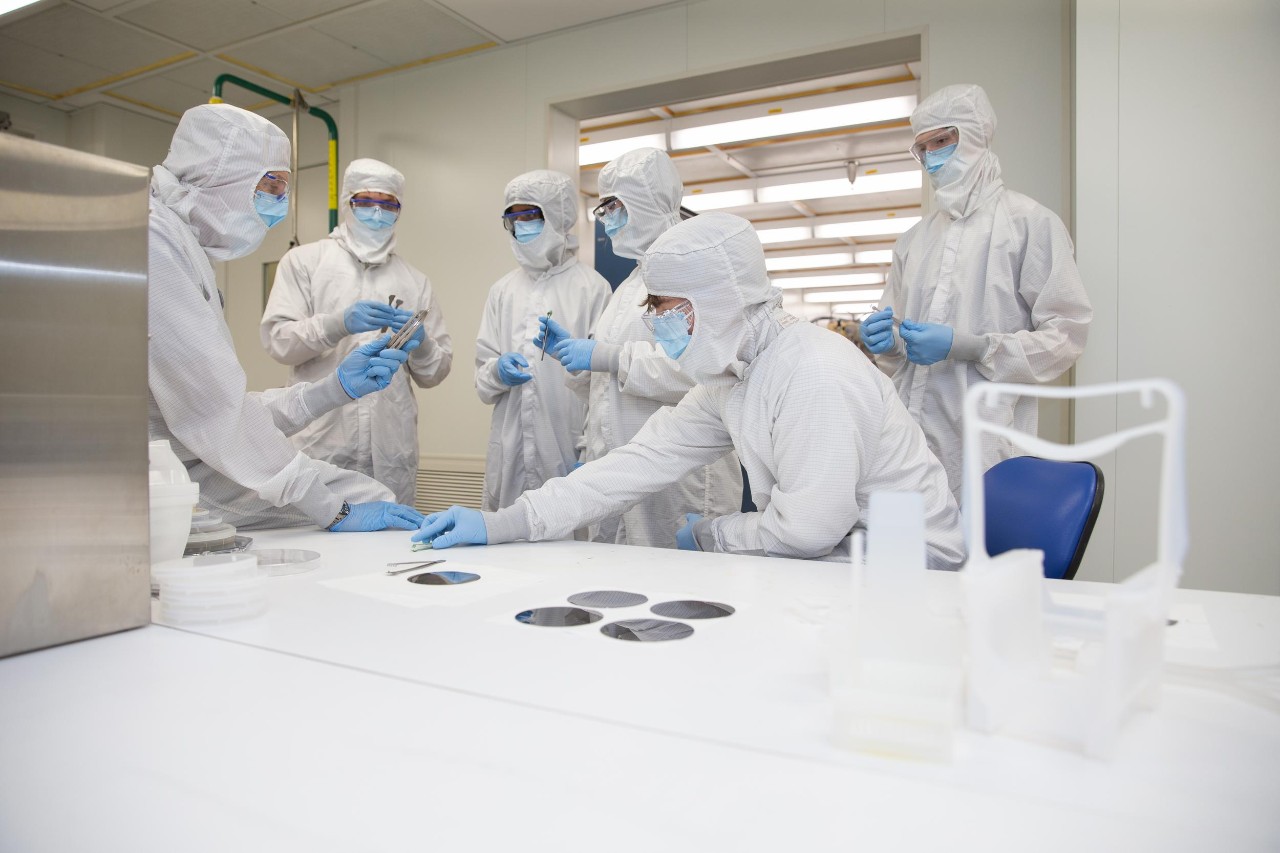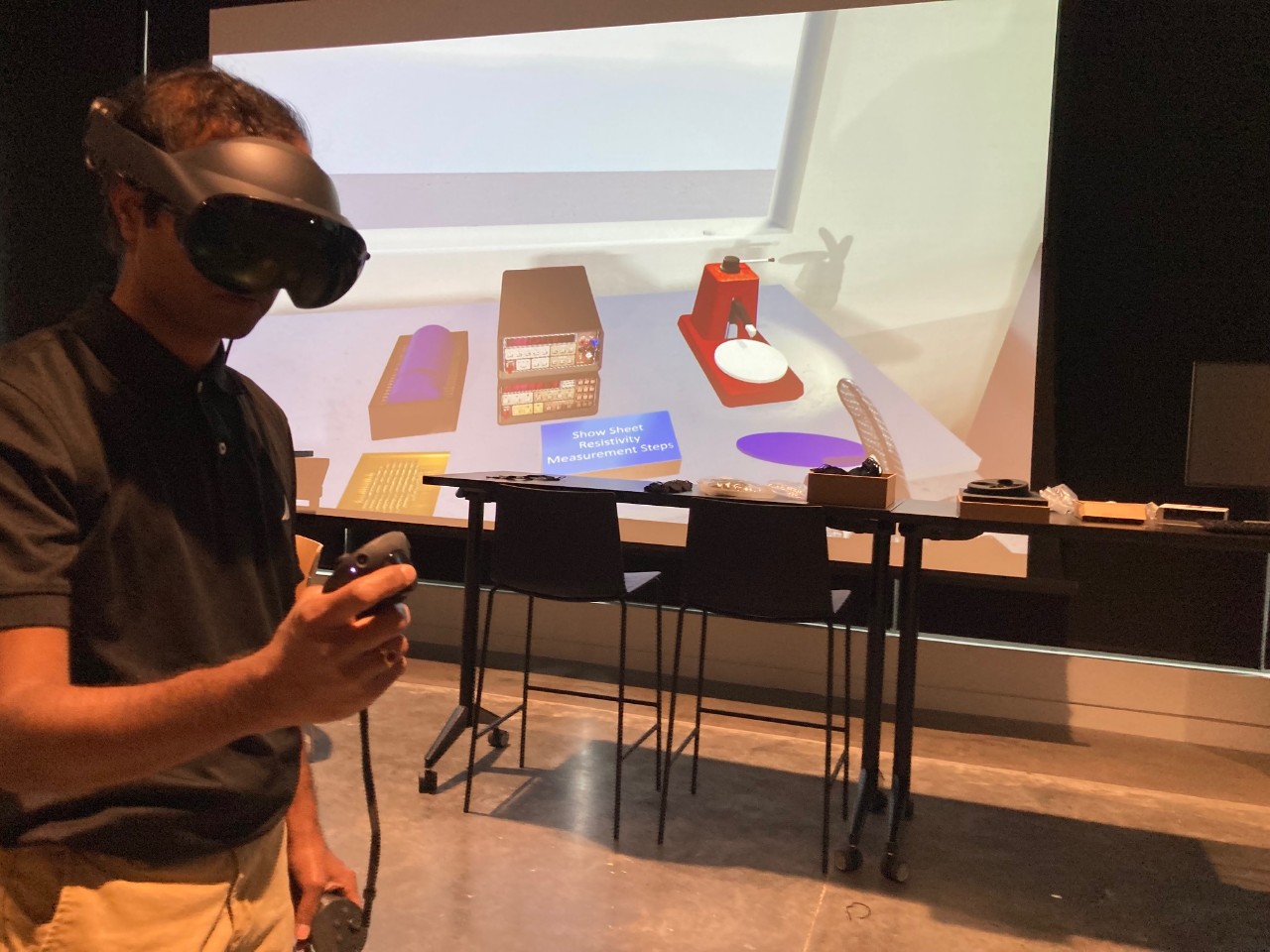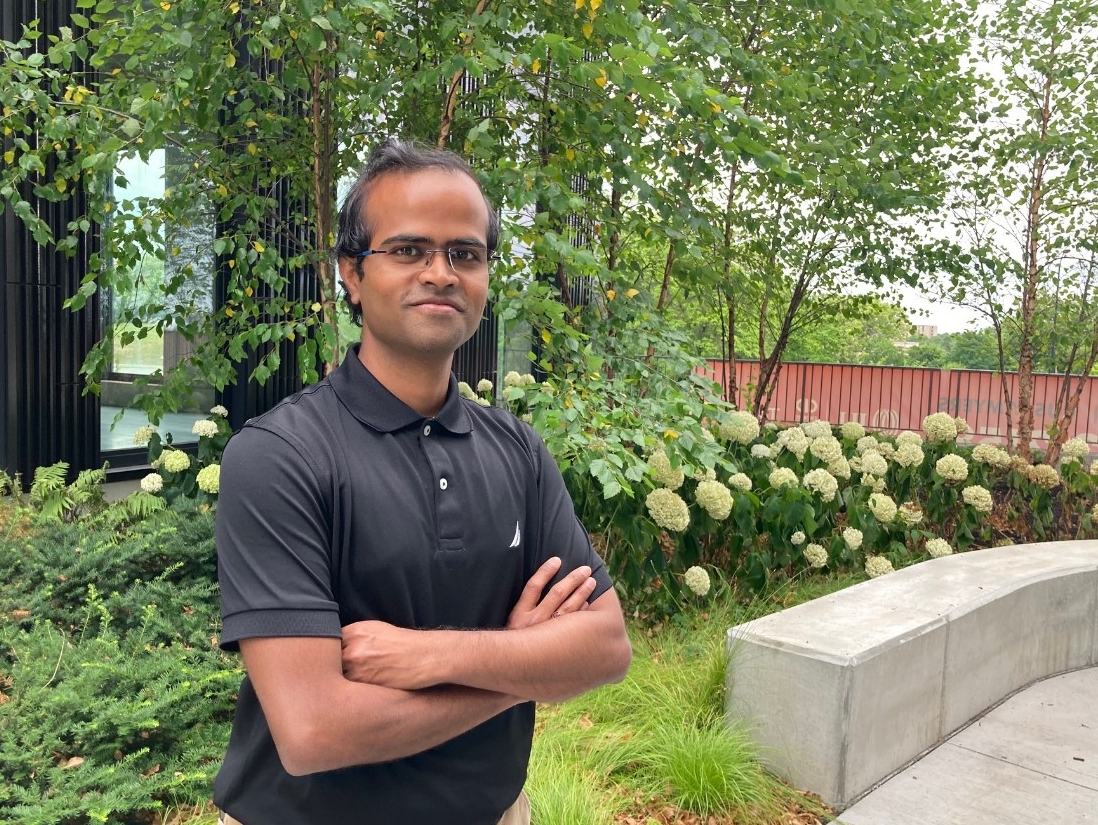
UC’s microchip training includes innovative VR
University welcomes first students into new credentialing program
To build a virtual microchip factory, University of Cincinnati doctoral students turned to the real one where they work.
Shailesh Padalkar, Manish Aryal and Anuj Gautam took exacting measurements of machines and workspaces in UC’s Mantei Center clean room to develop a three-dimensional virtual world designed to train new workers for semiconductor manufacturing.
The three students work under the supervision of College of Engineering and Applied Science Professor Sam Anand in UC’s Smart Manufacturing Lab at Digital Futures. The lab focuses on research in virtual and augmented reality for smart or digital manufacturing and training.
“In collaboration with Ron Flenniken, who is the senior clean room engineer, we took measurements of each piece of equipment to build 3D models so it was an exact replica of what we have at UC,” Padalkar said.

A student works with microchip fabrication equipment in UC's Mantei Center cleanroom. Photo/Andrew Higley/UC Marketing + Brand
Padalkar designed the VR simulator from scratch using Siemens NX 3-D modeling software and the Unreal Engine, software used to make popular games such as Fortnite. He has been working on developing the VR chip manufacturing training modules for the past two years.
UC is using both simulation and in-person instruction in the 8,000-square-foot clean room to train its first group of students in the basics of microchip manufacturing as part of a coalition of 15 colleges and universities called the Ohio Southwest Alliance on Semiconductors and Integrated Scalable Manufacturing.
The goal is to begin preparing students and workers for new high-tech jobs at places like Intel Corp., which is building its first microchip fabrication plant outside Columbus, Ohio.
In 2022, UC organized the higher-education group to train students and workers in semiconductor technology and manufacturing. Intel awarded UC and its partners $3.5 million over three years to provide training.

UC is training students and workers in microchip fabrication as part of the Ohio Southwest Alliance on Semiconductors and Integrated Scalable Manufacturing. Photo/Andrew Higley/UC Marketing + Brand
UC expects to train 1,000 students by the end of 2025.
Marc Cahay, head of UC’s Department of Electrical and Computer Engineering, is planning to expand the microcredentials developed with the support of Intel into a new certificate in semiconductor materials, devices, and circuits, which is expected to appeal to a wide audience of scientists and engineers.
UC played host to a workshop in June to give students a bird’s eye view of the field of semiconductors, covering the fundamentals of chip design and manufacturing. The students received hands-on experience with equipment similar to the kind found at chipmakers such as Intel.
Clean rooms provide a controlled environment that is kept free from contaminants that could affect the sensitive microchips. Before entering, students donned head-to-toe coveralls with hoods, gloves, masks and slip-resistant boots to prevent dust and other contaminants from fouling the sensitive electronics.
Like a squire helping a knight with their armor, a graduate student helped the students with the hoods and hard-to-reach snaps. After learning more about the machines, the students worked with equipment such as a mask aligner used in photolithography.
A virtual clean room is convenient. You can do the training or practice your skills almost anywhere. And it provides feedback that shows you where you might need more skills training.
Sam Anand, UC College of Engineering and Applied Science
High school senior Brooklyn Barnes, of Columbus, Ohio, said she is considering following her dad into engineering. Barnes said she was excited about getting to work with actual semiconductor fabrication equipment.
“Once I get out of college, I’ll be ready,” she said.
Tim Agnello, a high school science teacher in Cincinnati, enrolled in the training to learn more about what goes into making microchips.
“Half my job is getting kids excited about science,” he said.
“I’m trained as a geologist, but I teach physical and earth science to eighth-graders. The whole process of getting silicon from quartz and turning it into a microchip is interesting to me,” he said. “The more of this I learn, the more I can relate the science to my students.”
At UC’s Digital Futures building, Agnello got to try virtual reality for the first time. He recognized the benefits of using VR to introduce students to the concepts of microchip manufacturing.
“It was very cool — a little disorienting at first,” he said. “But you press a button and teleport to a different part of the room. And to pick things up — in virtual reality, you could turn gravity off and stack items in space in front of you.”

UC doctoral student Shailesh Padalkar uses VR goggles to work with microchip fabrication equipment in a virtual clean room. Padalkar began training the first students during a workshop at Digital Futures. Photo/Michael Miller
UC's Anand is no stranger to using simulations in industry. He and his students employ technology such as digital twins that use computer simulations to make real-time adjustments to manufacturing machines in industrial settings.
He said the VR system offers some notable advantages.
“Clean rooms have expensive equipment. You can’t just walk in and use it. And there are very few of them around the country,” he said. “A virtual clean room is convenient. You can do the training or practice your skills almost anywhere. And it provides feedback that shows you where you might need more skills training.”
Anand said if the simulated exercises are fun and engaging, students are more likely to retain what they’ve learned.
UC will be offering more training classes to prepare workers for jobs at microchip manufacturers across the country, particularly Intel, which will need to fill 3,000 positions at its new Ohio plant when it opens in 2027.
Featured image at top: Students learn the basics of lab safety and microchip fabrication in UC's Mantei Center Cleanroom. Photo/Andrew Higley/UC Marketing + Brand

UC doctoral student Shailesh Padalkar designed a virtual clean room to help train workers and students in microchip manufacturing. Photo/Michael Miller
Next Lives Here
The University of Cincinnati is leading public urban universities into a new era of innovation. Our faculty, staff and students are saving lives, changing outcomes and bending the future in our city's direction. Next Lives Here.
Related Stories
UC joins national CyberCorps to defend America’s cyberspace
February 11, 2021
The University of Cincinnati received a $4 million award from the National Science Foundation to establish a Cybersecurity Scholarship for Service program.
Co-op launched UC alumnus’ Intel career
May 3, 2022
Intel vice president James Breisch got his start in computer engineering through UC's top-ranked co-op program.
UC engineering student demystifies crypto through co-op
December 17, 2021
University of Cincinnati student Jake Hemmerle pursued his interest in cryptocurrency in co-ops that promise to launch a career in computer science.
UC launches training for new Intel jobs
June 6, 2023
The University of Cincinnati is training the first of the approximately 20,000 workers Intel Corp. plans to hire at the microchip fabrication plants it is building in southwest Ohio.
UC’s microchip training includes innovative VR
July 2, 2024
To build a virtual microchip factory, University of Cincinnati doctoral students turned to the real one where they work. UC launched a new training program for microchip manufacturing in advance of the new fabrication plant Intel Corp. is opening in Ohio.
Intel's Ohio plants promise opportunity for UC
January 25, 2022
Intel Corp. announced on Friday it will open two new semiconductor fabrication plants outside Columbus as part of an estimated $20 billion investment in Ohio. The three-year construction project represents the biggest private investment in the history of the state, offering the promise of new high-tech jobs for thousands of residents, including many graduates of the University of Cincinnati.
UC-developed AI offers insight into conversations using physiology alone
February 13, 2023
Could an app let you know if a first date is just not into you? Engineers at the University of Cincinnati say the technology might not be far off. They trained a computer to identify the type of conversation two people were having based on their physiological responses alone.
UC honors students to lawmakers: Here are ideas to fix public education
December 2, 2020
On Dec. 7, University of Cincinnati honors students in the Save our Schools! seminar will present Ohio political leaders with their best ideas to address some of the state’s thorniest education issues at an educational reform symposium, to be held via remote technology.
Traffic of tomorrow
June 10, 2020
More driverless cars. More networked roads. More naps. UC is helping change how we drive.
UC students see rapid rise with their startup idea
March 14, 2024
Two University of Cincinnati students gave themselves just 30 minutes to come up with an idea for a startup business. Not only did they succeed, their idea has won multiple pitch competitions in the past year. Joe Kuncheria Panjikaran and Aniruddhan Ramesh are the founders of PhizzIO (pronounced “fizz-e-oh”), a startup that’s creating a business-to-business solution to improve physical therapy.
